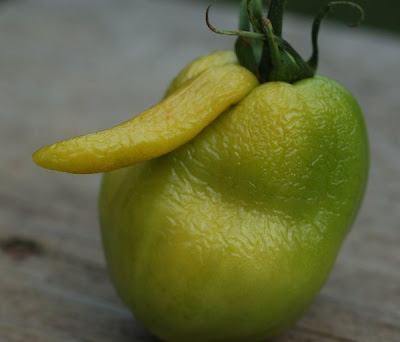My tomato seeds have sprouted, and have joined the broccoli and red cabbage seedlings on the windowsill. This year, I tried two varieties that have done well for me in the past, and two new ones.
Of all the tomatoes I grew last year, the only ones that did well for me were the Amish Paste from Seed Savers' Exchange. Here's their photograph and description:

Amish Paste Tomato. Heirloom discovered in Wisconsin. Produces 6-8 oz. red fruits that are oxheart to almost teardrop-shaped. Meaty fruits are juicy and have really outstanding flavor. Good for sauce or fresh eating. Indeterminate, 85 days from transplant.
Here's what happened in our garden:

The disquieting distortions of these tomatoes, combined with the poor growing season, discouraged me from saving the seeds. (I did, however, can 40 quarts of salsas and sauces. They tasted fine.) I ordered a new packet of these tomatoes this year. The other heirloom varieties I tried, Hillbilly and Spitze, didn't seem worth another try. The Hillbilly is a "potato-leaf variety." The tater bugs confirmed for me that the leaves resemble potato plants chemically as well as visually, and there was significant leaf damage on some plants. The Hillbillies were fairly productive, but the flavor wasn't great. This was probably due to the weather, but I decided to try something different this year. The Spitzes grew lush, beautiful vines, but they didn't produce many tomatoes, and they were the only variety to blight last year. This is just not the right tomato for Droop Mountain.
I started a packet of Brandywine Tomatoes. I've had reasonably good luck with these in the past, but I didn't have any seed left after last year.

(Sudduth's Strain) Brandywine first appeared in the 1889 catalog of Johnson & Stokes of Philadelphia and by 1902 was also offered by four additional seed companies, but soon disappeared from all commercial catalogs. Our best selling tomato and one of the best tasting tomatoes available to gardeners today. The seed of this strain was obtained by tomato collector Ben Quisenberry of Big Tomato Gardens in 1980 from Dorris Sudduth Hill whose family grew them for 80 years. Large pink beefsteak fruits to 2 pounds. Incredibly rich, delightfully intense tomato flavor. Indeterminate, 90 days from transplant.
My experiments this year will be a short season variety, Bloody Butcher, and Cherokee Purple, a variety that just sounded interesting.

Bloody Butcher Very early and high yielding variety. Great full tomato flavor and exceptional dark red color. Fruits are borne in clusters and average 4 oz. Indeterminate, 65-70 days from transplant.

Cherokee Purple Introduced to other SSE members by North Carolina member Craig LeHoullier in 1991, seed obtained from J. D. Green. Unique dusty rose color. Flavor rivals Brandywine, extremely sweet. Productive plants produce large crops of 12 oz. fruits. Indeterminate, 80 days from transplant.
1 comment:
Interesting to see your tomato photos! Years ago I was a member of the Seed Saver's Exchange and I tried several of the potato-leaf varieties such as Brandywine.
In a perfect year they produced wonderful-tasting fruits, but as you mentioned pests were a problem, and distorted fruits occurred unless the plants were watered daily, especially during a drought period.
Post a Comment